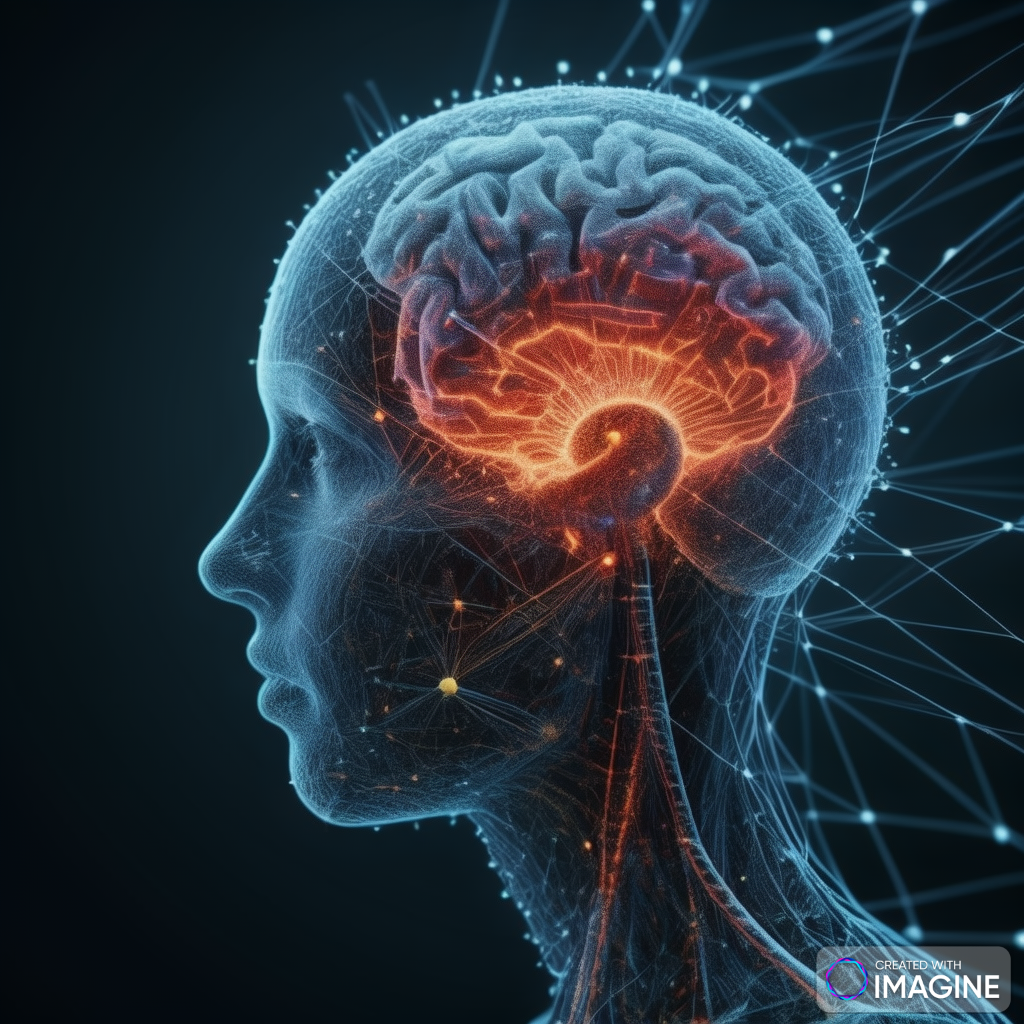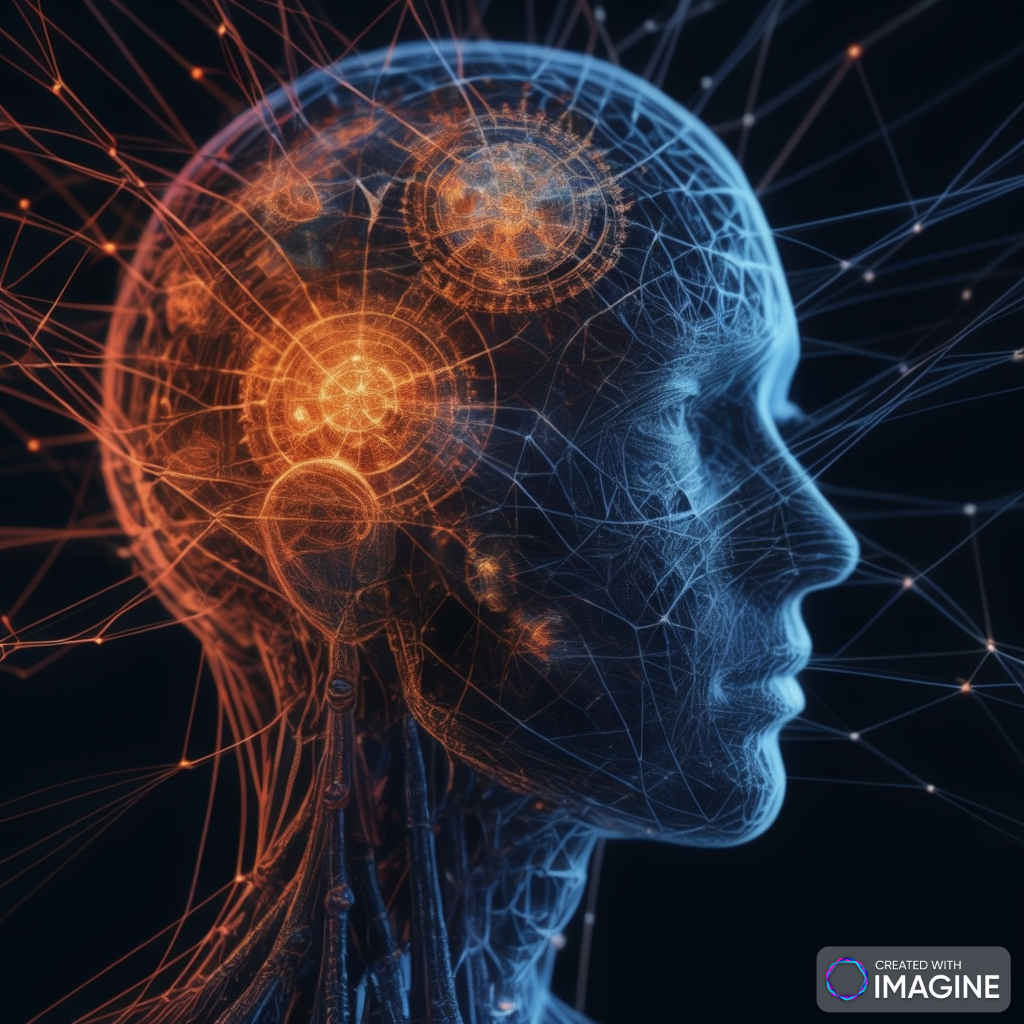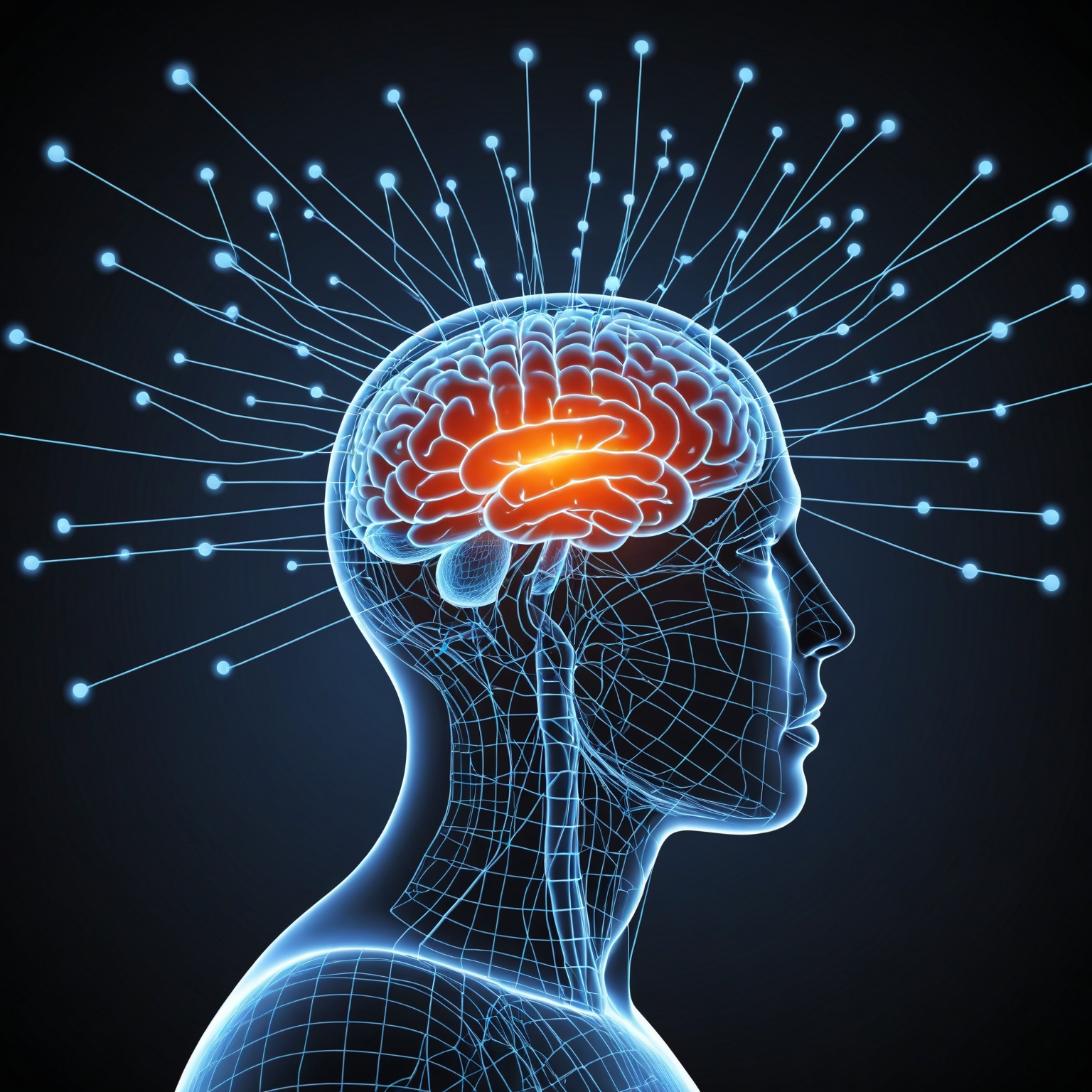Introduction: Embark on a journey into the intricate workings of the human brain as we delve deep into the fascinating question: How does the brain process information? In this comprehensive exploration, we will unravel the complexities of Neuroscience, cognitive functions, and the remarkable mechanisms that enable us to perceive, learn, and make sense of the world around us.
- The Neural Architecture: Understanding the Brain’s Information Processing Network
- The human brain is a marvel of complexity, comprised of billions of interconnected neurons that form an intricate network responsible for processing and transmitting information. At the core of this network are neurons, specialized cells that serve as the building blocks of the nervous system. Neurons communicate with each other through electrochemical signals transmitted across tiny gaps called synapses.
- Neurons come in various shapes and sizes, but they share common structural features. Each neuron consists of a cell body, dendrites, and an axon. The cell body contains the nucleus and other organelles necessary for cellular function. Dendrites are branched extensions that receive incoming signals from neighboring neurons, while the axon is a long, slender projection that transmits signals away from the cell body to other neurons or target cells.
- The communication between neurons occurs through electrochemical impulses known as action potentials. When a neuron receives a signal from a neighboring neuron, it generates an electrical impulse that travels down its axon. This electrical signal triggers the release of neurotransmitters, chemical messengers stored in synaptic vesicles at the axon terminals. Neurotransmitters cross the synaptic gap and bind to receptor sites on the dendrites of the receiving neuron, initiating a new electrical signal in the postsynaptic neuron.
- The strength and efficacy of synaptic connections between neurons play a crucial role in information processing and neural communication. Synaptic plasticity, the ability of synapses to strengthen or weaken over time in response to activity, is a fundamental mechanism underlying learning and memory formation. Through processes like long-term potentiation (LTP) and long-term depression (LTD), synaptic connections are modified in response to repeated patterns of activity, allowing the brain to adapt and learn from experience.
- The collective activity of billions of neurons and trillions of synaptic connections forms complex neural networks that underlie various cognitive functions, including perception, memory, learning, and decision-making. These networks exhibit both localized specialization, with specific brain regions dedicated to particular functions, and distributed processing, with information processed across interconnected regions.
- Overall, the intricate network of neurons and synapses in the brain forms the foundation of its remarkable information processing capabilities, enabling humans to perceive, understand, and interact with the world around them. Understanding the structure and function of this neural network is essential for unraveling the mysteries of brain function and cognition.
- Within the brain, information is transmitted and encoded through a complex interplay of neurotransmitters, electrical impulses, and neural pathways. These components work together to facilitate communication between neurons and encode sensory input, thoughts, emotions, and memories.
- Neurotransmitters are chemical messengers that play a crucial role in transmitting signals between neurons. When an action potential reaches the presynaptic neuron’s axon terminal, it triggers the release of neurotransmitters into the synaptic cleft, the narrow space between neurons. Neurotransmitters then bind to receptor sites on the postsynaptic neuron’s dendrites, initiating a cascade of events that either excites or inhibits the postsynaptic neuron, depending on the type of neurotransmitter and receptor involved.
- There are many types of neurotransmitters, each with unique functions and effects on neural activity. For example, glutamate is the primary excitatory neurotransmitter in the brain, responsible for promoting neural activity and facilitating synaptic transmission. In contrast, gamma-aminobutyric acid (GABA) is the primary inhibitory neurotransmitter, which helps regulate neural excitability and maintain overall balance in the brain.
- The transmission of information through neurotransmitters occurs across neural pathways, which are specific routes of communication between different brain regions. These pathways consist of interconnected neurons that form circuits responsible for processing specific types of information. For example, the visual pathway transmits visual information from the eyes to the visual cortex, where it is processed and interpreted.
- In addition to neurotransmitters, electrical impulses called action potentials play a crucial role in information transmission within the brain. Action potentials are rapid changes in membrane potential that propagate along the axons of neurons, allowing signals to be transmitted over long distances. This process, known as neural firing, enables neurons to communicate with one another and transmit information across the brain rapidly.
- The encoding of information within the brain involves the transformation of sensory input and cognitive processes into patterns of neural activity. This process occurs through the coordinated firing of neurons within specific brain regions and neural networks. For example, when you see an object, visual information is processed by specialized regions of the brain, such as the visual cortex, where it is encoded into neural patterns that represent the object’s shape, color, and motion.
- Overall, the intricate interplay of neurotransmitters, electrical impulses, and neural pathways enables the brain to transmit and encode information essential for perception, cognition, and behavior. Understanding these mechanisms sheds light on how the brain processes information and provides insights into neurological disorders and cognitive functions.
- Sensory Perception: From Stimulus to Sensation
- Sensory organs play a crucial role in gathering information about the external environment and converting it into neural signals that the brain can interpret. The process by which sensory organs capture stimuli and transmit them as neural signals involves intricate mechanisms tailored to each sense.
- Vision (Eyes):
- The eyes are responsible for capturing visual stimuli from the surrounding environment. Light enters the eye through the cornea, passes through the pupil (whose size is regulated by the iris), and is focused by the lens onto the retina at the back of the eye.
- The retina contains specialized photoreceptor cells called rods and cones. Rods are sensitive to low light levels and are responsible for night vision, while cones are sensitive to color and detail under normal lighting conditions.
- When light strikes the photoreceptor cells, it triggers a cascade of biochemical reactions that generate electrical signals. These signals are then transmitted via the optic nerve to the visual cortex in the brain for processing.
- Audition (Ears):
- The ears capture sound waves from the environment and convert them into neural signals that the brain can interpret as sound. Sound waves enter the outer ear and travel through the auditory canal to reach the eardrum.
- The vibrations of the eardrum are transmitted to the three small bones of the middle ear (the ossicles), which amplify and transmit the vibrations to the cochlea, a spiral-shaped structure in the inner ear filled with fluid.
- Within the cochlea, specialized hair cells convert the mechanical vibrations into electrical signals. These signals are then transmitted via the auditory nerve to the auditory cortex in the brain for interpretation.
- Touch (Skin and other tactile receptors):
- The skin and other tactile receptors distributed throughout the body detect various forms of touch, pressure, temperature, and pain stimuli from the environment.
- Mechanoreceptors in the skin respond to mechanical stimuli such as pressure and vibration, while thermoreceptors detect changes in temperature, and nociceptors detect potentially harmful stimuli such as extreme pressure or temperature.
- When these receptors are stimulated, they generate electrical signals that travel along sensory nerve fibers to the somatosensory cortex in the brain, where the signals are processed to generate the sensation of touch or pain.
- In summary, sensory organs play a vital role in capturing external stimuli and converting them into electrical signals that are transmitted to the brain. The brain then processes these signals to create the rich sensory experiences that form the basis of perception and cognition.
- The brain’s ability to process and integrate sensory information from various modalities is essential for creating our perceptions of the world. Each sensory modality—sight, sound, touch, taste, and smell—provides unique inputs to the brain, which are then synthesized to form a coherent and comprehensive representation of our surroundings.
- Visual Processing:
- Visual information is processed primarily in the occipital lobe, located at the back of the brain. Within the occipital lobe, different regions specialize in analyzing specific aspects of visual stimuli, such as color, shape, motion, and depth.
- The primary visual cortex receives signals from the eyes via the optic nerve and processes basic visual features such as edges and contrast. Higher-order visual areas then integrate this information to form more complex representations of objects, faces, and scenes.
- Visual processing also involves feedback loops between different brain regions, allowing for top-down influences such as attention and expectations to modulate perception.
- Auditory Processing:
- Auditory information is primarily processed in the temporal lobes, located on the sides of the brain. The primary auditory cortex analyzes basic auditory features such as pitch, loudness, and timbre.
- Like visual processing, auditory processing also involves hierarchical organization, with higher-order auditory areas extracting more complex features such as speech sounds, music, and environmental sounds.
- Auditory processing also relies on feedback mechanisms and interactions with other sensory modalities, such as vision, to aid in speech perception and sound localization.
- Somatosensory Processing:
- Somatosensory information from the skin, muscles, joints, and internal organs is processed in the somatosensory cortex, located in the parietal lobe. Different regions of the somatosensory cortex specialize in processing information from different parts of the body.
- Somatosensory processing allows us to perceive sensations such as touch, pressure, temperature, and pain. Additionally, proprioceptive signals from muscles and joints provide information about body position and movement.
- Gustatory and Olfactory Processing:
- Gustatory (taste) information is processed in the gustatory cortex, located in the insular cortex of the brain. Taste receptors on the tongue detect different tastes (sweet, sour, salty, bitter, umami), and this information is transmitted to the brain via the cranial nerves.
- Olfactory (smell) information is processed in the olfactory cortex, located in the temporal lobe. Odor molecules in the air are detected by olfactory receptors in the nose and transmitted to the brain via the olfactory nerve.
- Integration of Sensory Information:
- The brain integrates information from multiple sensory modalities to create a unified perceptual experience of the world. This integration occurs through complex neural networks and feedback loops between different brain regions.
- Multisensory integration allows us to perceive the world as a coherent whole, combining information from different senses to enhance perception, aid in object recognition, and facilitate navigation in the environment.
- Additionally, higher-order cognitive processes such as attention, memory, and emotion also influence sensory processing and perception, shaping our subjective experiences of the world.
- Memory Formation: Encoding, Storage, and Retrieval
- Memory formation involves a complex interplay of neural processes that allow us to encode, store, and retrieve information for later use. Understanding these mechanisms sheds light on how memories are formed and retained in the brain.
- Encoding:
- Encoding is the initial process of transforming sensory input into a form that can be stored in memory. This process involves converting information from our sensory experiences into neural codes that the brain can process.
- Different types of encoding mechanisms exist depending on the nature of the information. For example, semantic encoding involves encoding the meaning of information, while visual encoding involves encoding visual details.
- The hippocampus, a structure located in the medial temporal lobe of the brain, plays a critical role in the encoding process by consolidating information from short-term memory into long-term memory.
- Storage:
- Once information is encoded, it is stored in various regions of the brain for later retrieval. The brain does not have a single storage location for memories; instead, memories are distributed across different neural networks.
- Short-term memory, also known as working memory, temporarily holds information that is currently being processed. It has limited capacity and duration and is supported by regions such as the prefrontal cortex.
- Long-term memory involves the storage of information over extended periods, ranging from minutes to years or even a lifetime. Memories are stored in networks of neurons distributed throughout the brain, with specific regions responsible for different types of memories (e.g., the hippocampus for episodic memories and the cortex for semantic memories).
- Retrieval:
- Retrieval is the process of accessing stored information from memory when needed. It involves reconstructing the encoded information from long-term memory and bringing it back into conscious awareness.
- Retrieval cues, such as environmental context, emotions, or associations, can trigger the recall of specific memories. These cues activate the neural pathways associated with the encoded information, facilitating its retrieval.
- The process of retrieval can be influenced by various factors, including the strength of the memory trace, interference from competing memories, and the individual’s cognitive state at the time of retrieval.
- Overall, memory formation relies on the dynamic interplay between encoding, storage, and retrieval processes, orchestrated by complex neural networks distributed throughout the brain. Understanding these mechanisms provides insights into how memories are formed, retained, and recalled, shaping our experiences and perceptions of the world.
- Understanding the various types of memory sheds light on how different forms of information are processed, stored, and accessed in the brain. Here’s an in-depth look at the main types of memory:
- Short-Term Working Memory:
- Short-term working memory, often referred to simply as working memory, is responsible for temporarily holding and manipulating information needed for ongoing cognitive tasks.
- Working memory has a limited capacity and duration, typically holding information for a few seconds to minutes.
- This type of memory is crucial for tasks that require immediate processing and manipulation of information, such as mental arithmetic, problem-solving, and comprehension of spoken language.
- Working memory is primarily supported by regions of the prefrontal cortex and parietal cortex, which are involved in attention, executive function, and cognitive control.
- Long-Term Declarative Memory:
- Declarative memory refers to the conscious, explicit memory for facts, events, and concepts that can be verbalized or consciously recalled.
- It is further subdivided into semantic memory, which stores general knowledge and facts about the world (e.g., knowing that Paris is the capital of France), and episodic memory, which stores personal experiences and events (e.g., remembering your first day of school).
- Declarative memories are encoded and stored in the neocortex, particularly in regions such as the hippocampus and surrounding medial temporal lobe structures.
- Retrieval of declarative memories involves conscious recollection and can be influenced by contextual cues and associations.
- Long-Term Procedural Memory:
- Procedural memory, also known as implicit memory, refers to the unconscious memory for skills, habits, and procedures that are acquired through repetition and practice.
- Unlike declarative memory, procedural memory does not rely on conscious awareness or verbalization and is typically expressed through performance rather than explicit recall.
- Procedural memories are stored in regions of the brain involved in motor control and skill learning, including the basal ganglia, cerebellum, and motor cortex.
- Retrieval of procedural memories often occurs automatically and is demonstrated through the execution of learned behaviors, such as riding a bike or playing a musical instrument.
- Overall, the brain employs distinct neural mechanisms to process and store different types of memory, reflecting the diverse cognitive functions and behaviors supported by the human mind. Understanding these memory systems provides insights into how information is encoded, retained, and utilized in various contexts, from everyday tasks to complex cognitive endeavors.
- Learning and Plasticity: Adapting to New Information
- Synaptic plasticity and neural rewiring are fundamental processes underlying the brain’s remarkable ability to learn, adapt, and reorganize in response to new experiences and information. Here’s an in-depth exploration of these phenomena:
- Synaptic Plasticity:
- Synaptic plasticity refers to the ability of synapses, the connections between neurons, to change in strength and efficacy over time.
- This process allows for the modification of synaptic transmission, influencing the strength of neuronal connections and communication within neural circuits.
- The two main forms of synaptic plasticity are long-term potentiation (LTP) and long-term depression (LTD), which respectively involve the strengthening and weakening of synaptic connections.
- LTP occurs when repeated stimulation of a synapse leads to an increase in synaptic strength, enhancing the transmission of signals between neurons. This process is crucial for the consolidation of learning and memory.
- LTD, on the other hand, involves the weakening of synaptic connections in response to prolonged low-frequency stimulation or lack of activity. LTD plays a role in pruning unnecessary or inefficient synaptic connections, refining neural circuits and optimizing brain function.
- Neural Rewiring:
- Neural rewiring, also known as neural plasticity or neuroplasticity, refers to the brain’s ability to reorganize its structure and function in response to learning, experience, and injury.
- This process involves the formation of new synaptic connections, the pruning of existing connections, and the remapping of neuronal networks to adapt to changing environmental demands.
- Neural rewiring occurs throughout life, from early development through adulthood and into old age, reflecting the brain’s ongoing capacity for adaptation and growth.
- Factors such as learning, sensory experiences, physical exercise, and environmental enrichment can promote neural rewiring by stimulating the formation of new synapses and strengthening existing connections.
- Neural rewiring is particularly prominent during critical periods of development, such as early childhood, when the brain is highly plastic and responsive to environmental input.
- In the context of recovery from injury or neurological disorders, neural rewiring plays a crucial role in rehabilitation and functional recovery, allowing the brain to compensate for damage by reorganizing neural circuits and restoring lost function.
- Overall, synaptic plasticity and neural rewiring are dynamic processes that underlie learning, memory, and adaptation in the brain. By understanding these mechanisms, researchers can gain insights into how experiences shape brain structure and function, paving the way for interventions to enhance cognitive abilities, promote recovery from injury, and mitigate the effects of neurological disorders.
- Experience:
- Experience refers to exposure to sensory stimuli, environmental cues, and cognitive tasks that engage the brain’s neural networks.
- When we engage in new activities or encounter novel information, sensory receptors transmit signals to the brain, activating specific neural circuits associated with processing that information.
- Through experience, the brain forms associations between sensory inputs, cognitive processes, and behavioral responses, leading to the formation of new neural connections and pathways.
- For example, when learning to play a musical instrument, repeated exposure to musical notes and motor movements leads to the strengthening of synaptic connections in brain regions responsible for auditory processing, motor control, and coordination.
- Repetition:
- Repetition involves the repeated exposure to stimuli or the performance of tasks over time, which reinforces neural activation patterns and enhances synaptic plasticity.
- With each repetition, neural circuits involved in the task become more strongly interconnected, leading to the consolidation of learning and the automatization of skills.
- Repetition strengthens synaptic connections through processes like long-term potentiation (LTP), which enhances the efficacy of synaptic transmission and promotes the encoding of information into long-term memory.
- For instance, practicing a dance routine or memorizing multiplication tables involves repeated rehearsal of specific movements or facts, leading to the formation of robust neural representations that support skill acquisition and retention.
- Reinforcement:
- Reinforcement involves the provision of rewards or punishments following certain behaviors, influencing the likelihood of those behaviors occurring in the future.
- Positive reinforcement, such as praise or rewards, strengthens neural connections associated with behaviors that lead to desirable outcomes, thereby promoting learning and skill acquisition.
- Negative reinforcement, such as the removal of aversive stimuli, can also reinforce behaviors by reducing discomfort or stress, leading to changes in neural circuitry that support adaptive responses.
- Reinforcement influences learning by modulating neurotransmitter release, particularly dopamine, which plays a key role in reward processing and motivation.
- In educational settings, providing feedback, praise, or rewards for correct responses can reinforce desired learning outcomes and encourage continued engagement in learning activities.
- In summary, experience, repetition, and reinforcement are integral components of the learning process, shaping neural plasticity and facilitating the acquisition of new skills and knowledge. By understanding how these principles influence brain function, educators, therapists, and individuals can optimize learning experiences and enhance cognitive development.
- Higher Cognitive Functions: Thinking, Reasoning, and Decision-Making
- Higher-order thinking encompasses complex cognitive processes that go beyond simple recall or recognition tasks. These processes involve critical analysis, synthesis of information, and the application of knowledge to solve problems, make decisions, and engage in abstract reasoning. Let’s explore each of these components in detail:
- Problem-solving:
- Problem-solving involves identifying, analyzing, and implementing solutions to challenging or novel problems.
- The process typically begins with problem identification, where individuals recognize the existence of a problem or goal that requires resolution.
- Next, problem analysis involves breaking down the problem into manageable components, gathering relevant information, and identifying potential strategies or approaches.
- During problem-solving, individuals engage in critical thinking, applying logical reasoning, creativity, and domain-specific knowledge to generate and evaluate potential solutions.
- Finally, individuals implement and evaluate the effectiveness of their chosen solution, adjusting their approach as needed based on feedback and outcomes.
- Decision-making:
- Decision-making involves selecting from among alternative courses of action to achieve a specific goal or outcome.
- The process of decision-making is influenced by factors such as the availability of information, time constraints, uncertainty, and individual preferences or values.
- Decision-makers often employ cognitive strategies such as weighing pros and cons, considering risks and benefits, and evaluating the potential consequences of different options.
- Decision-making may be intuitive or systematic, depending on the complexity of the decision and the individual’s expertise in the relevant domain.
- Effective decision-makers are able to anticipate outcomes, evaluate trade-offs, and make informed choices that align with their objectives.
- Abstract reasoning:
- Abstract reasoning involves the ability to think conceptually, analyze patterns, and draw inferences without relying solely on concrete, tangible information.
- It requires individuals to manipulate symbols, ideas, and mental representations in their minds to identify relationships, recognize patterns, and draw conclusions.
- Abstract reasoning is essential for tasks such as analogical reasoning, deductive and inductive logic, and problem abstraction.
- It allows individuals to generalize knowledge across different contexts, recognize underlying principles or rules, and adaptively apply learned concepts to new situations.
- Abstract reasoning skills are particularly important in fields such as mathematics, science, philosophy, and creative endeavors, where the ability to think abstractly facilitates innovation and problem-solving.
- In summary, higher-order thinking involves cognitive processes such as problem-solving, decision-making, and abstract reasoning, which enable individuals to navigate complex challenges, make informed choices, and engage in creative problem-solving. Developing and honing these skills is crucial for success in academic, professional, and personal endeavors.
- Executive functions refer to a set of cognitive processes that enable individuals to regulate their thoughts, actions, and emotions in order to achieve goals and adapt to changing environments. Among the key components of executive functioning are attention, inhibition, and cognitive control, each playing a crucial role in guiding thought processes and behavior:
- Attention:
- Attention refers to the ability to focus cognitive resources on specific stimuli or tasks while ignoring distractions.
- It encompasses different aspects, including selective attention (the ability to focus on relevant information while ignoring irrelevant stimuli), sustained attention (the ability to maintain focus over time), and divided attention (the ability to attend to multiple tasks simultaneously).
- Attentional control allows individuals to allocate cognitive resources efficiently, prioritize information, and sustain mental effort in pursuit of goals.
- Deficits in attention can lead to difficulties in maintaining focus, organizing thoughts, and completing tasks, impairing overall cognitive functioning and task performance.
- Inhibition:
- Inhibition involves the ability to suppress irrelevant or automatic responses, resist distractions, and control impulsive behaviors.
- It plays a critical role in self-regulation, allowing individuals to inhibit prepotent or habitual responses in favor of more adaptive behaviors.
- Inhibition is essential for decision-making, impulse control, and social behavior, as it enables individuals to override immediate desires or temptations in pursuit of long-term goals.
- Impaired inhibition may manifest as impulsivity, distractibility, or difficulty with behavioral control, contributing to challenges in academic, social, and occupational domains.
- Cognitive control:
- Cognitive control refers to the capacity to flexibly regulate cognitive processes, such as attention, memory, and problem-solving, in order to achieve desired outcomes.
- It involves processes such as goal setting, planning, monitoring, and adjusting behavior in response to feedback or changing circumstances.
- Cognitive control allows individuals to adaptively allocate cognitive resources, switch between tasks, and maintain goal-directed behavior in the face of competing demands or distractions.
- Dysfunction in cognitive control can result in difficulties with planning, organization, and task switching, leading to inefficiencies in problem-solving and decision-making.
- In summary, executive functions such as attention, inhibition, and cognitive control are essential for guiding thought processes and behavior, facilitating goal-directed behavior, and promoting adaptive functioning in various contexts. Strengthening these executive skills through targeted interventions, practice, and environmental supports can enhance cognitive functioning and promote success in academic, professional, and personal pursuits.
- Emotions and Motivation: Influencing Information Processing
- The interplay between emotions, motivation, and information processing in the brain is a complex and dynamic phenomenon that influences various aspects of cognitive functioning and behavior:
- Emotional Influence on Information Processing:
- Emotions play a significant role in shaping how information is perceived, interpreted, and remembered. Positive emotions, such as happiness or excitement, can enhance attention and memory, making information more salient and memorable. Conversely, negative emotions, such as fear or sadness, can narrow attentional focus and impair memory encoding, leading to selective processing of emotionally relevant information.
- The amygdala, a key brain structure involved in emotion processing, modulates attention and memory by prioritizing emotionally significant stimuli. It can enhance the processing of emotionally arousing information, facilitating rapid responses to potential threats or rewards.
- Motivational Influence on Information Processing:
- Motivation refers to the internal processes that drive behavior and goal-directed action. Motivational states, such as hunger, thirst, or desire for social approval, can influence attention, perception, and decision-making processes.
- Motivational cues or incentives can enhance information processing by directing attention and cognitive resources toward goal-relevant stimuli. For example, the prospect of earning a reward may increase motivation and engagement in a learning task, leading to improved performance.
- Dopamine, a neurotransmitter associated with reward and motivation, plays a central role in modulating information processing by encoding the salience or value of stimuli. Dopaminergic pathways originating from the ventral tegmental area (VTA) to various brain regions, including the prefrontal cortex and nucleus accumbens, mediate the motivational aspects of cognition.
- Interaction between Emotions, Motivation, and Cognitive Control:
- Emotions and motivation can interact with cognitive control processes, such as attentional allocation, inhibitory control, and decision-making. For instance, emotional arousal can enhance or impair cognitive control depending on the context and individual differences.
- High levels of arousal associated with strong emotions may enhance attentional focus on emotionally salient stimuli but may also impair inhibitory control or cognitive flexibility. This can lead to impulsive decision-making or difficulty in regulating emotions in challenging situations.
- The prefrontal cortex, particularly the dorsolateral prefrontal cortex (DLPFC) and ventromedial prefrontal cortex (VMPFC), plays a crucial role in integrating emotional and motivational signals with cognitive control processes. These regions are involved in evaluating the emotional significance of stimuli, regulating emotional responses, and implementing goal-directed behavior.
- In summary, the interplay between emotions, motivation, and information processing in the brain is a dynamic process that influences cognitive functioning and behavior in various contexts. Understanding how emotions and motivation shape cognitive processes can provide insights into the mechanisms underlying decision-making, learning, and adaptive behavior in everyday life.
- Understand how emotional states and motivational factors can influence perception, memory, and decision-making processes.
- Neural Networks and Computational Models: Insights from Neuroscience and AI
- Neuroscience has provided valuable insights into the workings of the brain, inspiring the development of artificial neural networks (ANNs) and computational models that aim to mimic biological information processing mechanisms. These models leverage the structure and function of biological neurons to perform tasks such as pattern recognition, decision-making, and learning.
- One of the foundational concepts borrowed from neuroscience is the neuron, the basic building block of the brain’s information processing system. In ANNs, artificial neurons, or nodes, are interconnected in layers to form a network. Each neuron receives input signals, processes them using weighted connections, and generates an output signal based on an activation function. This process closely resembles the transmission of signals between biological neurons in the brain.
- Furthermore, the structure of ANNs often mirrors the hierarchical organization observed in the brain’s neural circuits. Different layers of neurons perform specialized functions, with information passing through successive layers to extract increasingly complex features from raw data. This hierarchical processing enables ANNs to learn abstract representations of input patterns, similar to how the brain processes sensory information to recognize objects or interpret language.
- Additionally, the learning algorithms used in ANNs are inspired by principles of synaptic plasticity observed in biological brains. For example, supervised learning algorithms adjust the synaptic weights between neurons based on feedback signals, allowing the network to learn from labeled training data. Reinforcement learning algorithms, on the other hand, use reward signals to reinforce or modify synaptic connections, guiding the network towards desirable behaviors over time.
- Advances in neuroscience research have also influenced the development of computational models that simulate specific brain functions or cognitive processes. For instance, models of visual processing have been inspired by the hierarchical organization of the visual cortex, while models of memory formation draw upon principles of synaptic plasticity and neural network dynamics.
- Moreover, interdisciplinary collaborations between neuroscientists, computer scientists, and engineers have led to the integration of cutting-edge technologies such as functional neuroimaging, electrophysiology, and neuromorphic hardware into the study of artificial intelligence. These technologies enable researchers to investigate the neural correlates of cognitive functions and develop more biologically plausible models of information processing.
- In summary, insights from
 have played a pivotal role in the development of artificial neural networks and computational models of information processing. By emulating the structure and function of the brain, these models hold promise for advancing artificial intelligence, robotics, and cognitive science, paving the way for innovative applications in various domains.
have played a pivotal role in the development of artificial neural networks and computational models of information processing. By emulating the structure and function of the brain, these models hold promise for advancing artificial intelligence, robotics, and cognitive science, paving the way for innovative applications in various domains. - Neural networks and artificial intelligence (AI) algorithms are computational models inspired by the structure and function of the brain’s information processing mechanisms. These models have found widespread applications across diverse fields, ranging from machine learning and data analysis to robotics and autonomous systems.
- At the core of neural networks is the concept of artificial neurons, or nodes, which are organized into layers and interconnected through weighted connections. Each neuron receives input signals, applies a transformation function to compute an output, and transmits this output to other neurons in the network. This process closely resembles the transmission of signals between biological neurons in the brain.
- One of the key strengths of neural networks lies in their ability to learn from data. Through a process known as training, neural networks adjust the weights of connections between neurons to minimize the difference between predicted outputs and actual outcomes. This learning process allows neural networks to recognize patterns, make predictions, and perform tasks such as image classification, speech recognition, and natural language processing.
- In the field of machine learning, neural networks are applied in supervised learning tasks, where the model learns from labeled training data to make predictions or classify inputs into different categories. Convolutional neural networks (CNNs), for example, excel at tasks involving image recognition and computer vision, while recurrent neural networks (RNNs) are well-suited for sequential data processing tasks like speech recognition and language translation.
- Beyond traditional machine learning tasks, neural networks are also employed in reinforcement learning, where agents learn to make decisions through trial and error interactions with an environment. Reinforcement learning algorithms, such as deep Q-networks (DQNs) and policy gradient methods, have been used to train autonomous agents to play complex video games, control robotic systems, and optimize resource allocation in various domains.
- In robotics, neural networks play a crucial role in enabling robots to perceive and interact with their environments autonomously. By processing sensor data and making real-time decisions, neural network-based controllers allow robots to navigate complex environments, manipulate objects, and learn from their experiences to improve performance over time.
- Furthermore, advancements in hardware acceleration, parallel computing, and algorithmic optimization have accelerated the deployment of neural networks in real-world applications. Graphics processing units (GPUs), tensor processing units (TPUs), and specialized hardware accelerators have been developed to efficiently train and deploy large-scale neural networks for tasks such as image recognition, autonomous driving, and natural language understanding.
- In summary, neural networks and AI algorithms mimic the brain’s information processing mechanisms and have revolutionized various fields, from machine learning to robotics. By harnessing the power of data and computation, these models enable intelligent systems to perceive, learn, and interact with the world in ways previously thought impossible, driving innovation and shaping the future of technology.
Conclusion: As we conclude our journey into the depths of the brain’s information processing capabilities, we gain a newfound appreciation for the complexity and elegance of the human mind. From sensory perception to higher cognitive functions, the brain’s ability to process information is a testament to millions of years of evolution and ongoing scientific discovery. By understanding how the brain processes information, we unlock insights that not only deepen our understanding of ourselves but also inspire innovations in technology, healthcare, and beyond.






